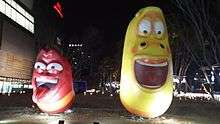Animation in South Korea
South Korean animation, or aeni (/ˈæni/; Korean: 애니), has become an industry that produces characters for other countries' companies, exports its creations globally and generates billions of dollars in profits.
| Animation in South Korea | |
| Hangul | 애니, 만화영화 |
|---|---|
| Revised Romanization | aeni, manhwa yeonghwa |
| McCune–Reischauer | aeni, manhwa yŏnghwa |
Etymology
The word aeni comes from the English word "animation" as written in Hangeul, 애니메이션 (aenimeisyeon), similar to Japanese アニメーション (animēshon). Just like anime, aenimeisyeon was shorten to aeni. However, aeni usually refers to Japanese animation in colloquial usage,[1] although it can refer to Korean animation or animation in general. To distinguish it from its Japanese counterpart, Korean animation is often called hanguk aeni (Korean: 한국 애니; lit. Korean animation)[2] or guksan aeni (Korean: 국산 애니; lit. domestic animation).[3]
A Sino-Korean term manhwa yeonghwa (Korean: 만화영화; Hanja: 漫畫映畫), a portmanteau of manhwa and the Korean term for movie, is also used as a general term for all animation.[4]
History

The South Korean animation industry was in a period of crisis throughout the 2000s. Depression at the reality of being an industry that the West merely gave factory-type drawing to began to sink in. This followed the 1990s, a period of explosive growth for the industry when Korean studios made most of their profits from OEM, mostly from the United States.
In many ways, 2011 was a bright transitional year for Korean animation, with home-produced animated feature films finally finding box office success in South Korea, instead of facing the usual financial failure. As far as overseas export market is concerned, the likes of Rough Draft Korea (RDK) kept on landing new contracts, which have seen Rough Draft perform the manual work on over 45 popular Western cartoon titles over 16 years.[5]
South Korean animation has boomed in popularity in Eastern Asia with the success of the series Pororo the Little Penguin and Origami Warriors in 2011, leaving fans wanting to discover more Korean animations. This success is due in part to perfecting the Korean animation technique, and financial returns being reinvested into new animated products.
Some Korean animators still blame the booming Korean game industry for draining the animation industry's talent pool,[6] but the box office success of the Korean animated film Leafie[7] in 2011 in South Korea is inspiring a new generation.
Animation industry
Animation contracts for Korean animation studios range from collaboration/minor contribution contracts, to most of the work. The South Korean animation industry can be considered dynamic as there are more than a hundred animation studios. While it is mostly firms in South Korea that contract with Western studios, some of the work is reported to be subcontracted to North Korea as well.[8]
Korean animation characters in public spaces
- Larva subway was a subway based on and featured a Larva character. It operated from November 2014 until May 2015 on line No. 2. The Seoul government and Metro explained that they wanted to give citizens a chance to celebrate the 40th anniversary of the subways opening.[9]
- Tayo buses were organized by the Seoul Metropolitan Government, the Bus Transport Business Association, and the animation company which made Tayo the Little Bus for the Public Transportation Day. In 2014, the Seoul Metropolitan Government commissioned buses designed as the characters of Tayo the Little Bus to go around the Gwanghwamun Square area of the city.[10]
- In 2014, statues of Larva and Pororo the Little Penguin were installed in World Park, which is a square in the Lotte World II Hotel. They were well received by citizens and tourist.[11]
Market
In 2010, according to the Korea Creative Content Agency, the Korean market share of domestic characters was about 28% and the remaining 72% was for foreign characters, such as those from Japan and USA. In 2012, experts predicted that the total market size would grow to 10 trillion won (about 9 billion dollars in July 2018) in the near future .[12] In 2014, the domestic character market share soared to 40% and its value in 2013 had reached 8 trillion won (about 7 billion dollars).
Korean characters as international business
Before the emergence of Korean domestic characters, characters that enjoyed popularity were mostly from the United States and Japan.[13] However, as the industry matured and grew in size, domestic characters received preference not just domestically but also internationally.
See also
- Anime
- Cinema of Korea
- Chinese animation
- Manhwa
- Taiwanese animation
- Video gaming in South Korea
- Webtoon
References
- "Laftel.net".
- Kim, Se Yeong (2017-09-12). ""독창성 사라진 한국 애니…아쉽다"" ["Korean animation has lost originality...a disappointment"]. The Asia Business Daily.
- Choe, Jin Hwan (2020-04-07). "국산 애니 '바이트초이카', 18일 첫 방송" [Domestic animation 'Bite-Choicar' airs first episode on the 18th]. Hankook Ilbo.
- "만화^영화" [manhwa yeonghwa]. Standard Korean Language Dictionary (revised ed.). National Institute of Korean Language. 2008-10-08.
- "Korazy Art Exhibit". Korazy.com.au. Archived from the original on 2012-04-26. Retrieved 2012-05-23.
- Applegate, Ben (2005-08-19). "Animators gather as industry faces transition". Korea JoongAng Daily. Archived from the original on 2016-03-10.
- "Finecut Sells Animated 'Leafie' to U.S., U.K., Australia". The Hollywood Reporter. 2011-11-22. Retrieved 2012-05-23.
- Lee, Sunny (2007-03-14). "US cartoons 'made in North Korea'". Asia Times. Archived from the original on 2007-03-21.
- Gang, Jieun (2015-05-29). "지하철 2호선 '라바 열차', 이달 운행 종료" ['Larve subway' on line No.2. End of this month]. Newsis.
- Oh, Wonseok (2014-04-02). "서울시'타요버스', 이렇게 찾아요" ['Tayo bus' of Seoul city, find this way]. Bloter.
- Song, Hwajung (2014-10-31). "롯데월드몰, 그랜드 오픈 기념 이벤트 풍성" [Lotte world mall grand open was well received]. Asia Economy.
- Oh, Daeseok (2014-12-28). "8조 캐릭터 시장, 도약하는 토종 캐릭터" [8 billion character market, Growing domestic character]. Business Post.
- Hyeyoung Chu, hyunju Lee, Hyehyun Cho, Mirae Hwang (Winter 2014). "Periodic Features of Korean Character Designs" (PDF). 3.1 Period of Published Cartoon Characters (1980s~1990s).CS1 maint: multiple names: authors list (link)
External links
- History of Korean animation
- History of robot anime of South Korea (in Japanese, with images & video clip)
- Korean animated movie posters
- Fanzine article listing RDK outsourced cartoons

